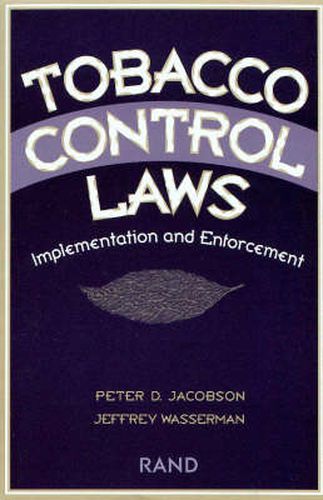Readings Newsletter
Become a Readings Member to make your shopping experience even easier.
Sign in or sign up for free!
You’re not far away from qualifying for FREE standard shipping within Australia
You’ve qualified for FREE standard shipping within Australia
The cart is loading…






In this study, the authors examined the process by which anti-tobacco laws and ordinances were implemented and enforced in seven states and 19 localities. Their findings indicated that state- and local-level clean indoor air laws were rarely enforced by government agencies. Instead, these laws were largely self-enforcing, in that changed social norms regarding appropriate smoking behavior have led to high compliance rates. In contrast, teen access laws were consistently and vigorously enforced, mainly through periodic vendor compliance checks that were conducted in many of the sites visited. The authors also found that anti-tobacco forces do not devote a significant amount of resources to implementation and enforcement issues. Rather, their attention is focused on enacting new legislation and fighting tobacco industry attempts to weaken existing laws through, for example, state preemption of local ordinances. Finally, the authors found that local enforcement is a critical ingredient to the success of virtually any tobacco control effort. The study’s results do not augur well for public health measures that require state-level enforcement that are opposed by powerful and politically well-connected interests. To be effective, legislation must contain specific enforcement measures, such as license removal by local authorities.
$9.00 standard shipping within Australia
FREE standard shipping within Australia for orders over $100.00
Express & International shipping calculated at checkout
In this study, the authors examined the process by which anti-tobacco laws and ordinances were implemented and enforced in seven states and 19 localities. Their findings indicated that state- and local-level clean indoor air laws were rarely enforced by government agencies. Instead, these laws were largely self-enforcing, in that changed social norms regarding appropriate smoking behavior have led to high compliance rates. In contrast, teen access laws were consistently and vigorously enforced, mainly through periodic vendor compliance checks that were conducted in many of the sites visited. The authors also found that anti-tobacco forces do not devote a significant amount of resources to implementation and enforcement issues. Rather, their attention is focused on enacting new legislation and fighting tobacco industry attempts to weaken existing laws through, for example, state preemption of local ordinances. Finally, the authors found that local enforcement is a critical ingredient to the success of virtually any tobacco control effort. The study’s results do not augur well for public health measures that require state-level enforcement that are opposed by powerful and politically well-connected interests. To be effective, legislation must contain specific enforcement measures, such as license removal by local authorities.